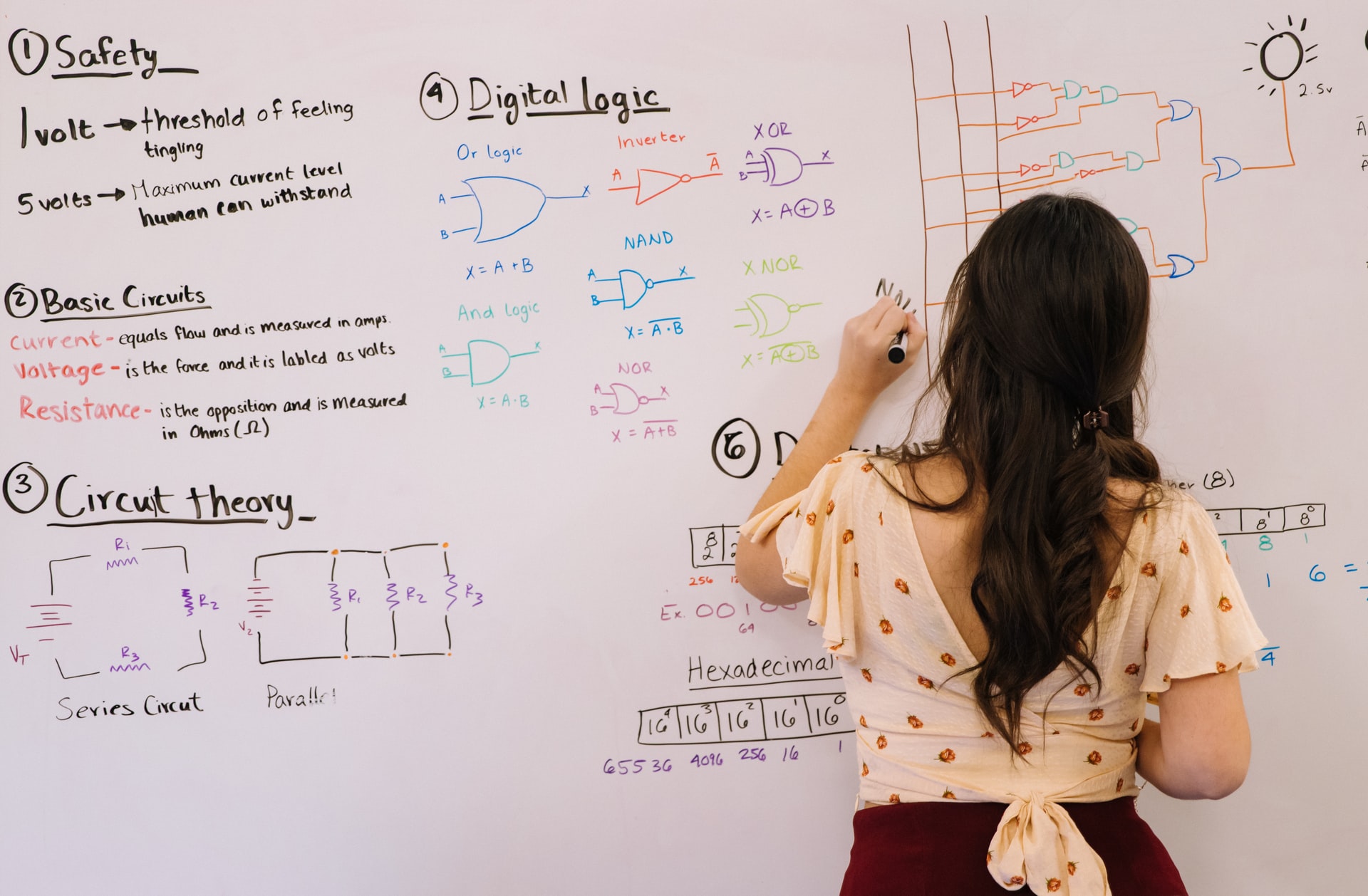Understanding and implementing remote active learning in 2021
How to stimulate students to keep practicing while studying math and statistics from home

by Pim Bellinga
Co-Founder of Grasple
Picture this. You’re giving an online lecture about Linear Algebra to a group of first-year engineering students. When you’re about to explain more about invertible matrices, you notice that most of your students have turned off their camera, indicating that they’re doing everything but participating, and interaction is nowhere to be found.
This situation is everyday practice for educators worldwide. When the COVID pandemic struck, students and lecturers had to abandon campus. Now, many students receive their education through online classrooms.
A lack of engagement
One of the most-heard frustrations concerning this form of education is that students are no longer engaged with the lecture. Especially with remote classes, teachers say they find it difficult to connect with their students. Being out of touch with their educators can negatively impact student engagement. In the long run, a lack of engagement can result in lower student achievements, as students learn more when they participate in the process of learning [1].
Based on historical learning trends and prior research on how out-of-school-time affects learning, this applies especially to mathematics and statistics (STEM) education[2]. The Brookings Institution estimated that, in 2020, math students were predicted to show smaller learning gains from the previous year, returning with less than 50% of typical gains[2]. Mostly due to being out of touch with their educators.
While these statements might sound worrying, a few solutions allow you to keep up your student’s engagement levels and, ultimately, their achievements. This is where remote active learning comes in.
 Some students lack engagement during (traditional or remote) lectures.
Some students lack engagement during (traditional or remote) lectures.
What is active learning?
Active learning is an educational method in which students are actively involved in the learning process to truly grasp the material. The term ‘active learning’ was coined in 1991 by Charles Bonwell and James Eison, and active learning methods now serve as a framework for students to engage with the learning material. Instead of passively listening and taking notes, active learning focuses on active student involvement through practicing, discussing, and solving problems.
In contrast to active learning, there’s passive learning. Here, students receive information from the instructor and memorize it – a teacher-centered method. A typical disadvantage of passive learning is that the emphasis is placed on repeating information without reflecting or establishing an understanding. This can result in surface processing instead of deeper learning, less ability to use what is learned, and the learning material being deemed irrelevant by the students[3].
“Active learning refers to classroom practices that engage students in activities, such as reading, writing, discussion, or problem-solving, that promote higher-order thinking.”
– Conference Board of the Mathematical Sciences
In contrast to surface processing in passive learning, active learning focuses on how students learn, not just on what they learn. The method is student-centered, and educational activities are meant for students to take part in their education. This approach is based on a theory called constructivism. Constructivism is nothing new, as it goes back to the days of Jean Piaget (1896–1980) and Lev Vygotsky (1896-1934). The educational theory emphasizes the fact that students should build (construct) their own understanding, allowing them to link concepts and information.
 In contrast to passive learning, active learning is a student-centered approach.
In contrast to passive learning, active learning is a student-centered approach.
Benefits of active learning
There are many different reasons for educators to use active learning strategies in their classrooms. Strategies are all focused on multisensory learning, as practices such as hearing, watching, and analogical reasoning lead to the most long-term physical changes in the brain and improve memory retention and information recall[4]. At Grasple, we believe that the most important reasons for turning to (remote) active learning are that it stimulates recall and maximizes student engagement.
When students are more engaged, they have the opportunity to impact their education positively, and they move from short-term to long-term retention, achieving more in-depth levels of understanding. As a whole, this means that active learning:
- Reinforces important material, concepts, and skills.
- Provides more frequent and immediate feedback to students.
- Creates personal connections to the material for students, which increases their motivation to learn.
- Allows students to practice essential skills more frequently.
- Builds self-esteem through conversations with other students.
- Creates a sense of community in the classroom through increased student-student and instructor-student interaction[5].
When it comes to STEM education, the active learning approach is needed for students to fully understand the concept of mathematics. Research shows that students only grasp the concept of mathematics when they practice it frequently[6]. In mathematics, lectures build upon each other, and when students do not master previous lectures or learning material, it becomes difficult to keep up.
Whether it’s on-campus or remote, active learning is a method that proves to be efficient in mastering STEM learning material because it motivates students to practice more frequently, leading to better achievements.
 Online or on-campus: active learning is proven to be an effective method for teaching STEM.
Online or on-campus: active learning is proven to be an effective method for teaching STEM.
The educator’s role
Applying active learning in a (virtual) classroom requires educators to practice a different role. In passive learning, teachers are seen as the source of knowledge and understanding. They send out their information for students to take it in. When it comes to active learning, teachers do not send information – they guide students to construct their own knowledge and understanding. Therefore, their role is to:
- Motivate students to understand and to continue when it gets hard.
- Guide students in the right direction.
- Select and design activities that foster understanding.
- Select proper tools to help students understand, collaborate and practice the learning material.
“The mind is not a vessel to be filled, but a fire to be kindled.”
– Plutarch, Greek Middle Platonist philosopher
To embrace this active learning vision, educators can use digital solutions and tools to implement active learning in their courses. While new instructional techniques cannot be implemented overnight, the most important thing is simply getting started.
Starting with active learning
Begin by choosing one of two active learning techniques that allow you to refresh your student’s prior knowledge. Offer them active instruction, such as digital peer-to-peer-presentations, writing a summary, or working through a case study. To keep students engaged, it’s vital that they genuinely understand their learning activity’s purpose and meaning.
Another approach to start with remote active learning is through deliberate practice, for example, with online practice platforms such as Grasple. We believe that high-quality education requires the motivation to understand, the right prior knowledge to build upon, activities to foster new links, and effort to retain understanding.
As mentioned before, active learning creates personal connections to the material, something that increases students’ motivation to learn. One way to emphasize this is to offer students personalized, immediate feedback on their efforts. At Grasple, we provide an active learning environment in the form of an online practice and assessment platform. Here, students can practice STEM learning material and instantly receive their results.
Grasple offers educators insights into where students are still struggling, allowing them to tailor their assignments to meet their needs. This approach completely transforms math and statistics education, as students are no longer passive recipients but actively take part to understand the content better.
 Using Grasple is a way to implement active learning in your courses
Using Grasple is a way to implement active learning in your courses
Active learning at TU Delft
Applying this to remote education in 2021, offering students an online practice platform means that educators can motivate students to actively construct their own mental models and links between concepts and information. Innovative educators who are making use of Grasple already see positive results. For example, Annoesjka Cabo, director of studies Interfaculty Education at TU Delft’s Electrical Engineering, Mathematics, and Computer Science faculty. With 15,000 students, her challenge in providing quality education is one related to interactivity and engagement. When COVID made on-campus education impossible, Grasple proved to be of high value, as Cabo and her team used our online practice and assessment platform for more than 35.000 remote exams.
“The question we were seeking to answer was: how to activate students? We all know that you only learn mathematics by doing mathematics, and it’s important to practice. Every lecture builds on a previous one, so if you don’t master the material, it’s hard to catch up.”
– Annoesjka Cabo, Director of studies, interfaculty education at Delft University of Technology
While remote lectures can sometimes feel like an emergency solution for teaching, active learning solutions such as Grasple are specifically designed for this type of education. Now, and in the long run. We constructed our platform and remote practice solution as an addition to regular courses and lectures. That’s why we like to emphasize that implementing active learning does not require you to abandon passive learning completely. Instead, we hope you see it as an addition to your current didactic methods. During remote education, but also when students and educators eventually return to campus.
Do you want to see how you can use Grasple for active learning? Take a look at our open exercises available for you to use. To implement these exercises in your online classroom, sign up for a free Teacher Demo Account and fuel remote education.
References
- [1] Judith Grunert O'Brien and Barbara Mills, The Course Syllabus: a learning-centered approach. Retrieved March 3rd 2021: https://books.google.nl/books?id=YdEhlWm96zIC&
- [2] The Brookings Institute, "How is COVID-19 affecting student learning?". Retrieved March 3rd 2021: https://www.brookings.edu/blog/brown-center-chalkboard/2020/12/03/how-is-covid-19-affecting-student-learning/
- [3] CIRTL Network, Lecturing: Advantages and Disadvantages of the Traditional Lecture Method. Retrieved March 3rd 2021: https://web.archive.org/web/20140311181116/http://www.cirtl.net/node/2570
- [4] Claire Hoogendoorn, “The Neuroscience of Active Learning”. Retrieved March 10th 2021: https://openlab.citytech.cuny.edu/writingacrossthecurriculum/2015/10/15/the-neuroscience-of-active-learning/
- [5] Cornell, “Active Learning”. Retrieved March 2nd 2021: https://teaching.cornell.edu/teaching-resources/engaging-students/active-learning
- [6] Grasple, “How Delft University of Technology uses open exercises in their blended learning environment in math education”. Retrieved March 10th 2021: https://www.grasple.com/customer-stories/delft-university-of-technology-open-math-exercises/




